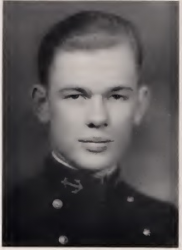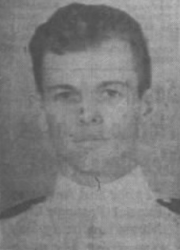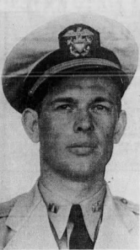
 |
|
|
||
|
Richard Halsey Best 'Dick' |
||||
|
Graduate, U.S. Naval Academy, Class of 1932 Engagements: • World War II (1941 - 1945) |
||||
| Biography: | ||||
|
Richard Halsey Best Lieutenant Commander, United States Navy Navy Cross & Distinguished Flying Cross Distinguished Flying Cross Citation: The President of the United States of America takes pleasure in presenting the Distinguished Flying Cross to Richard Halsey Best, Lieutenant Commander, United States Navy, for extraordinary achievement while participating in aerial flight as Division Leader in Plane 6-B-10. Lieutenant Commander Best executed several dive bombing attacks on enemy ships in Kwajalein Atoll, Marshall Islands, 1 February 1942, which resulted in severe damage to a large enemy transport and another cargo ship. Later this same day, Lieutenant Best, after beating off several attacks by enemy fighters which left his plane riddled with bullets, obtained a direct hit on an enemy hangar and remained after the original attack to strafe and ensure its complete destruction. His courage and actions on these occasions were in keeping with the highest traditions of the United States Naval Service. --------------------------------------------- Navy Cross Citation: The President of the United States of America takes pleasure in presenting the Navy Cross to Richard Halsey Best, Lieutenant Commander, United States Navy, for extraordinary heroism in operations against the enemy while serving as Pilot of a carrier-based Navy Dive Bomber and Squadron Commander in Bombing Squadron SIX, attached to the U.S.S. ENTERPRISE, during the "Air Battle of Midway," against enemy Japanese forces on 4 - 6 June 1942. Defying extreme danger from concentrated anti-aircraft barrage and powerful fighter opposition, Lieutenant Commander Best, with bold determination and courageous zeal, led his squadron in dive-bombing assaults against Japanese naval units. Flying at a distance from his own forces which rendered return unlikely because of probable fuel exhaustion, he pressed home his attacks with extreme disregard for his own personal safety. His gallant intrepidity and loyal devotion to duty contributed greatly to the success of our forces and were in keeping with the highest traditions of the United States Naval Service. General Orders: Commander In Chief Pacific Fleet: Serial 3144 (August 7, 1942) ------------------------------------------------ The Presidential Unit Citation presented to USS Enterprise (CV-6) and her Air Wing Six: For consistently outstanding performance and distinguished achievement during repeated action against enemy Japanese forces in the Pacific war area, 7 December 1941, to 15 November 1942. Participating in nearly every major carrier engagement in the first year of the war, the Enterprise and her air group, exclusive of far-flung destruction of hostile shore installations throughout the battle area, did sink or damage on her own a total of 35 Japanese vessels and shot down a total of 185 Japanese aircraft. Her aggressive spirit and superb combat efficiency are fitting tribute to the officers and men who so gallantly established her as an ahead bulwark in the defense of the American nation. Actions of the Enterprise mentioned in the citation include the Gilbert and Marshalls raid of 01 Feb 1942; Wake Island raid, 24 Feb 1942; Marcus Island raid, 04 Mar 1942; Battle of Midway, 4-6 Jun 1942; Occupation of Guadalcanal, 7-8 Aug 1942; Battle of Stewart Islands, 24 Aug 1942; Battle of Santa Cruz Islands, 26 Oct 1942; and Battle of Solomon Islands, 14-15 Nov 1942.-------------------------------- Task Force 16 Citation Recognizing its contribution to the Doolittle Raid, 18 April 1942 On the occasion of the 50th anniversary of the Second World War, it is appropriate that we take time to reflect on the unique and daring accomplishments achieved early in the war by Task Force 16. Sailing westward under sealed orders in April 1942, only four months after the devastating raid on Pearl Harbor, Task Force 16, carrying sixteen Army B-25 bombers, proceeded into history. Facing adverse weather and under constant threat of discovery before bombers could be launched to strike the Japanese homeland, the crews of the ships and LTC Doolittle's bombers persevered. On 18 April 1942 at 14:45, perseverance produced success as radio broadcasts from Japan confirmed the success of the raids. These raids were an enormous boost to the morale of the American people in those early and dark days of the war and a harbinger of the future for the Japanese High Command that had so foolishly awakened "The Sleeping Giant." These exploits, which so inspired the service men and women and the nation live on today and are remembered when the necessity of success against all odds is required. (Signed) John H.Dalton Secretary of the Navy 15 May 1995 ------------------------- Combat Action Ribbon (CR) note: None of the Navy/Marine flight crews in the Battle of Midway were eligible for or were awarded the Combat Action Ribbon (CR). See Navy and Marine Corps Awards Manual (SECNAVINST M-1650.1 of 16 Aug 2019, Appendix 2C.1.c (3) Amplifying Guidance). It reads in part, “The CR will not be awarded in connection with aerial flight, . . . “ The CR was established in 1969 and made retroactive to 07 Dec 1941. According to the Awards Manual, when deemed appropriate, the award for aerial combat is the Air Medal. ------------------------------ [Bio compiled by GML470] under construction 25 Jun 2020 |
||||
| Honoree ID: 319526 | Created by: GML470 | |||
Ribbons
Medals
Badges
Honoree Photos
 |  |  |
 |  |
 |


